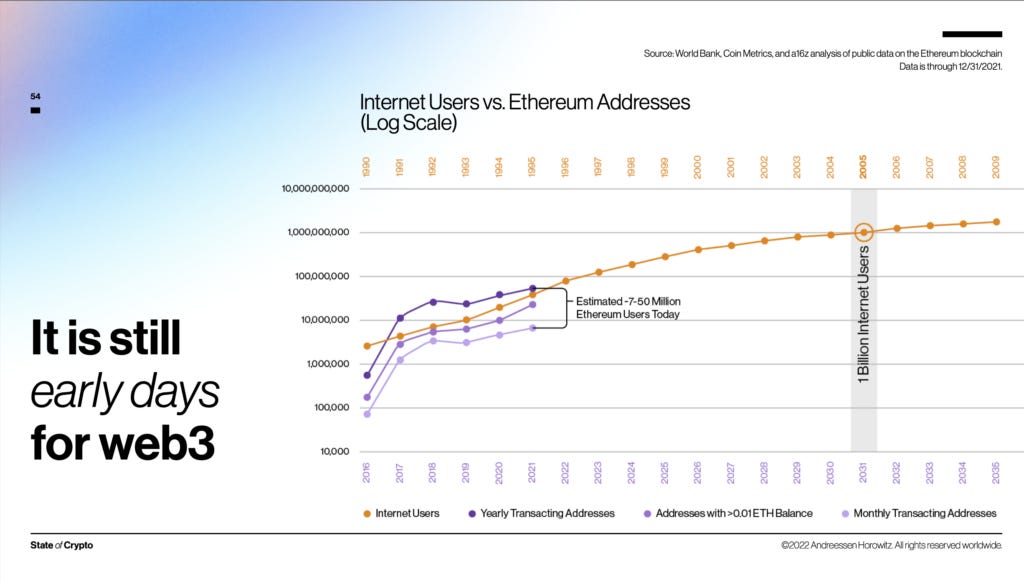Finding Equilibrium #14: State of Crypto, Origins of Drug Discovery, and Microsoft
Hello everyone!
After sending out the last issue, I went into the mountains for a 10-day silence retreat. No phones, no books, no internet, and no talking till the very last day. We weren’t even allowed to make eye contact or gestures to each other. It was easily one of the hardest but best things I’ve done – stay tuned for a blog post on my experience/learnings next time!
Being so offline means I’m still re-remembering how to use technology, so I’ve not done my usual internet scouring for this issue. I did find some gems these past few days though, so here’s a condensed issue with just 3 reads and 1 bonus for the week:
A neat benefit of the crypto market crash is the emergence of more data-driven industry reports. A16z put together this particular one, and it surveys the entire crypto landscape for patterns and stats. It’s excellent, especially if you’re someone who, like me, likes tapping through pretty slide decks. But if you prefer the summary, they’ve also captured their key takeaways here.
I particularly liked how they estimated the range of active Ethereum addresses to identify where web3 adoption is analogous to the internet’s. Comparing that figure to the internet’s active user count puts web3 in its 1995 era. Podcast hosts keep saying “we’re early”, but this was a handy data point to back that up!
Illumina caused rumbles in Biotech this month. They’re a DNA sequencing infrastructure company – they provide their DNA sequencing technology (the ability to examine a DNA molecule) to companies/researchers discovering and developing new drugs. But now, Illumina is kickstarting its own drug discovery program!
With Illumina's genomics and AI expertise, they could become one of the most tech-enabled future pharmaceutical companies. But moving from a "tools company" to a "discovery company" isn't trivial. There's a ton of skepticism around this move. To explore that skepticism, this essay outlines the history of today's pharmaceutical giants to see if they started as pure drug discovery companies.
Most of them didn't. They often generated momentum elsewhere before launching drug discovery. Novartis started in silk-dyeing, Merck was a German drug store, and Johnson & Johnson sold consumer products for 100 years. A common theme across them was developing the capacity for chemical synthesis. That's what helped them successfully shift into drug discovery and development.
Illumina's foundation in large-scale genomics feels like a viable parallel – as gene therapy proliferates, having an infrastructure to read and model genes is foundational – but who else could emerge in this next wave of tech-enabled pharmaceuticals? Companies like 23andMe will probably make the shift, but don't forget about our favorite tech giants. With the success of things like Alphafold, Alphabet has already launched their own biotech companies in Calico Labs (Aging Biotech) and Isomorphic labs (AI drug discovery). On the one hand, Alphabet has the capital. On the other, Illumina has the sequencing infrastructure. They have two different angles, but could both change what it means to be a Biotech company.
This was a treasure trove on Microsoft's history, path to being a $10T company, and lessons for the startup ecosystem. Microsoft successfully reinvented itself to be the cloud company (through Azure) instead of the Windows company, but the sheer scale of its Azure growth is eye-popping. It's a testament to Microsoft's core advantages: enterprise distribution, user trust, and superb engineering talent.
While AWS had to work hard to secure enterprises, Microsoft already had enormous enterprise distribution. That's what jumpstarted their growth. From there, the engineering talent and the trust continued to fuel their rapid initial trajectory. Part of this is because cloud computing became more mainstream, but that doesn't discount the power of those 3 primary advantages. Much of the article is a menu of acquisitions Microsoft could make to unlock enormous growth, but it's thoughtfully done and full of intriguing themes.

Bonus: Bionic Reading
Not the usual type of content I share, but this reading tool is awesome. It creates artificial fixation points in text (by bolding certain areas) to help us read faster. That stems from the fact that our brains read faster than our eyes, but we slow ourselves down by rolling our eyes over every letter. Speed reading has the same foundation: you train to minimize your eye movements. I’d tried it back when I was doing SATs and it never quite worked, but reading with this tool actually feels much smoother. It’s free and worth a try, especially if you’re reading some of the long articles I hit you with!
Thanks again for reading through, see you in 2 weeks!
Aqil

